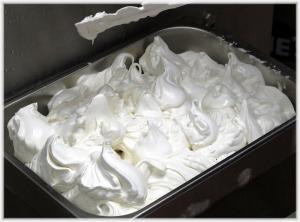I can still recall my first spoonful of gelato. On a summer trip to Italy, we were standing in the cobbled square of an Umbrian hillside town when we tasted the essence of ripe peaches – cold and creamy and bright. Our reaction to the combination of intense flavor and fragile texture was a little like Meg Ryan in the diner scene from “When Harry Met Sally.”
We hadn’t yet found a gelateria in this area that came anywhere close to matching that experience. That is, not until Gelato Gal opened on Route One in Rehoboth Beach. When we learned the shop offered classes on making this magical treat, we signed up for the five-hour immersion.
Gelato Gal Amanda Randall honed her skills at Carpigiani Gelato University where she developed an appreciation for the alchemy involved in making gelato. She generously shared recipes and techniques over the course of the day, but this was clearly a process that required lots of practice. She would teach the class how to assemble the ingredients and give us some insight into the artistry behind authentic gelato.
We began our class with the basics: what is gelato. Often referred to as Italian ice cream, gelato means “to freeze” – a nod to its origins in China as a dish of shaved ice flavored with concentrated fruit syrup. As this frozen dessert made its way into Italy, it retained its sorbet-like qualities in the south and became the dairy-based delight found in the north.
The key property of gelato is its unique chemical structure, the delicate balance of air, water, butterfat, milk solids and sugar. The recipe we worked from was simply a list of ingredients with a range of percentages that you could expect to tweak. The ideal proportions (about 65 percent water) create equilibrium between the liquid and solids for a result that is not too hard, not too icy, but perfectly smooth and flavorful.
In a process comparable to making the custard base for ice cream, gelato starts on the stovetop (unless you have an expensive commercial machine that handles this step far more conveniently). So that her students wouldn’t need to spend the entire day in her shop, Amanda shared her prepared base as the starting point for our flavored gelato.
Although made with similar ingredients, gelato is lower in fat (and about half the calories per serving) compared to ice cream. Because there’s less fat coating your tongue, you are better able to taste the subtle flavorings. When adding vanilla and ground cardamom for our batch, we were surprised at how little extract and spice were needed to infuse the entire bucket (and yes, we really did mix things up in a plastic bucket).
If we had made a fruit-flavored gelato, we would have needed a calculator: the amount of fruit has to be balanced with additional sugar based on the fruit’s inherent sweetness. Our handout was filled with tables and spreadsheets listing the percentages we would need to consult when trying new variations at home. The gelato shopping list should also include a metric scale, as the ingredients are measured by weight, not volume.
Once we were satisfied with the taste of each batch, we took turns pouring our buckets full of liquid into the commercial freezer-mixer. Our classmates Steve and Kristen made a rich chocolate cinnamon, and Amanda made a trial batch of peanut butter (she’s always experimenting). Within five minutes, the frozen gelato began to appear at the grate on the front of the machine and we scooped off rounded pieces into a chilled tray (see photo). Amanda had warned us that she would push the “I Love Lucy” button once we learned the scooping technique. As the gelato streamed out faster and faster, we picked up the pace but didn’t lose a drop.
We went home with generous samples of our freshly made gelato and lots of ideas for flavor combinations. I’m eager to try making gelato in my own kitchen, and if I need more inspiration, the Gelato Gal is open every day.
Gelato Gal Base
670 g whole milk (2 3/4 C)
105 g heavy cream (1/2 C)
35 g skim milk powder (1/4 C)
155 g sugar (3/4 C)
30 g dextrose (1/3 C)
Combine milk and cream in a saucepan and heat until quite warm – do not boil. In a large bowl, stir together the milk solids and sugars. Pour the warm liquid into the bowl about 1/2 C at a time, whisking thoroughly to incorporate the solids and blend the mixture to a smooth consistency. Cover the surface of the liquid with wax paper and chill for at least 2 hours. Finish the gelato following the manufacturer’s instructions on your ice cream maker. Pack in an airtight container and place in the freezer for at least four hours. Before serving, move the frozen gelato to the refrigerator for about 30 minutes to reach the correct consistency. Note: if you can not find dextrose, substitute 1/4 C sugar.
Gelato flavors – after cooling the base and before freezing the gelato you can stir in herbs, spices or other flavorings, e.g., cinnamon, ginger, vanilla; start with a scant 1/4 t and check the taste, adding more until it’s pleasing. If you add additional liquids or solids, you will need to adjust the balance of fat, sugar and water accordingly.
Gelato Gal – Gelato Gal serves coffee, dessert and artisan gelato in an array of constantly changing flavors. Visit the website for additional information and a schedule of upcoming classes go to gelatogal.com or call 302-227-1001.














.jpg)








































